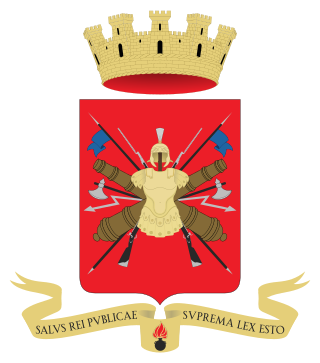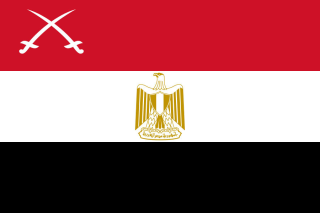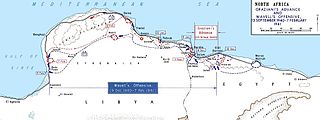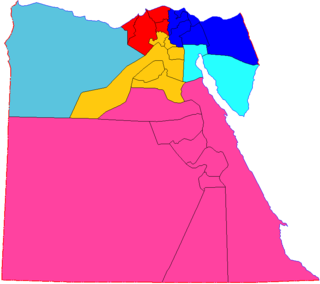A division is a large military unit or formation, usually consisting of between 10,000 and 25,000 soldiers. In most armies, a division is composed of several regiments or brigades; in turn, several divisions typically make up a corps.

Operation Compass was the first large British military operation of the Western Desert Campaign (1940–1943) during the Second World War. British Empire and Commonwealth forces attacked Italian forces of the 10th Army in western Egypt and Cyrenaica, the eastern province of Libya, from December 1940 to February 1941.

Operation Badr or Plan Badr was an Egyptian military offensive across the Suez Canal that destroyed the Bar-Lev Line, a chain of Israeli fortifications along the frontline of the Israeli-occupied Sinai Peninsula, on 6 October 1973. It was launched in conjunction with a Syrian military offensive against the Israeli-occupied Golan Heights, triggering the 1973 Arab–Israeli War. During the War of Attrition, which preceded Operation Badr, both Egypt and Syria had been seeking to recover the territories that Israel had captured from them during the 1967 Arab–Israeli War.

The Italian Army is the land force branch of the Italian Armed Forces. The army's history dates back to the Italian unification in the 1850s and 1860s. The army fought in colonial engagements in China, Libya, Northern Italy against the Austro-Hungarian Empire during World War I, Abyssinia before World War II and in World War II in Albania, Balkans, North Africa, the Soviet Union, and Italy itself. During the Cold War, the army prepared itself to defend against a Warsaw Pact invasion from the east. Since the end of the Cold War, the army has seen extensive peacekeeping service and combat in Afghanistan and Iraq. Its best-known combat vehicles are the Dardo infantry fighting vehicle, the Centauro tank destroyer and the Ariete tank and among its aircraft the Mangusta attack helicopter, recently deployed in UN missions. The headquarters of the Army General Staff are located in Rome opposite the Quirinal Palace, where the president of Italy resides. The army is an all-volunteer force of active-duty personnel.
The 10th Army was a field army of the Royal Italian Army, which fought in World War I and in Italian North Africa during World War II.

The Battle of the Chinese Farm took place during October 15 to October 17, 1973 between the Egyptian Army and the Israel Defense Forces (IDF), as part of the Yom Kippur War. It was fought in the Sinai Peninsula, north of the Great Bitter Lake and just east of the Suez Canal, near an Egyptian agricultural research station. The area was known to the Israeli military as the Chinese Farm – a misnomer resulting from the research station's use of Japanese-made equipment, with Japanese writing on the machinery mistaken by Israeli observers for Chinese characters.

The Battle of Abu-Ageila was a military confrontation between the Israel Defense Forces and the Egyptian Army in the Six-Day War of June 1967. The decisive defeat of the Egyptians was critical to the eventual loss of the entire Sinai Peninsula to Israel. Leading Israeli forces was Major General Ariel Sharon, later a prominent politician and prime minister of Israel.

The 2nd Mechanized Infantry Division of the Infantry Corps of the Egyptian Army is a heavy infantry formation created after the Second World War.

The Italian invasion of Egypt was an offensive in the Second World War, against British, Commonwealth and Free French in the neutral Kingdom of Egypt. The invasion by the Italian 10th Army ended border skirmishing on the frontier and began the Western Desert Campaign (1940–1943) proper. The Italian strategy was to advance from Libya along the Egyptian coast to seize the Suez Canal. After numerous delays, the scope of the offensive was reduced to an advance as far as Sidi Barrani and the engagement of any British forces in the area.

The Maletti Group(Italian: Raggruppamento Maletti) was an ad hoc mechanised unit formed by the Italian Royal Army in Italian North Africa, during the initial stages of the Western Desert Campaign of the Second World War. The Italian army had three armoured divisions in Europe but all were needed for the occupation of Albania and the forthcoming invasion of Greece, which began on 28 October 1940. The Raggruppamento Maletti was formed in June 1940, as part of the 10th Army and contained all of the M11/39 medium tanks in Libya.

The 63rd Infantry Division "Cirene" was an infantry division of the Royal Italian Army during World War II. The division was formed on 1 October 1937 in Benghazi in Italian Libya and named for the nearby antique city of Cyrene. The division's regimental depots were in mainland Italy in Liguria and shared with the 37th Infantry Division "Modena", with both divisions recruiting their troops from and training them there. The Cirene was classified as an auto-transportable division, meaning it had some motorized transport, but not enough to move the entire division at once. The division was destroyed on 5 January 1941 during the Battle of Bardia.

The 64th Infantry Division "Catanzaro" was an infantry division of the Royal Italian Army during World War II. The division was activated on 3 June 1940 and named for the Southern Italian city of Catanzaro. The division's regimental depots were in mainland Italy in Calabria and shared with other divisions recruiting in the region. The division was classified as an auto-transportable division, meaning it had some motorized transport, but not enough to move the entire division at once. The division took part in the Italian invasion of Egypt and was destroyed on 5 January 1941 during the Battle of Bardia.
This is the order of battle for Operation Badr, an Egyptian military operation that initiated the Yom Kippur War against Israel along the Suez Canal in the Sinai on October 6, 1973. As neither belligerent has released an official order of battle, this list remains incomplete and largely conjectural. An asterisk indicates Egyptian units that participated in the operation.

The Battle of Ismailia took place between the Egyptian Army and the Israeli Defense Forces (IDF) during the last stages of the Yom Kippur War during October 18–22, 1973, south of the city of Ismailia, on the west bank of the Suez Canal in Egypt. The battle itself took place as part of the larger IDF-launched Operation Abiray-Lev, in an attempt to seize Ismailia and thereby sever the logistical and supply lines of most of Egypt's Second Field Army across the Suez Canal.

The Battle of Sidi Barrani(10–11 December 1940) was the opening battle of Operation Compass, the first big British attack of the Western Desert Campaign of the Second World War. Sidi Barrani, on the Mediterranean coast in Egypt, had been occupied by the Italian 10th Army, during the Italian invasion of Egypt (9–16 September 1940) and was attacked by British, Commonwealth and imperial troops, who re-captured the port.
The Second Field Army is a military formation of the Egyptian Army, formed in 1968. Army headquarters is at Ismailia. It is usually commanded by a field commander of lieutenant-general rank of at least 34 years' service, and reports directly to the Army General Headquarters and General Staff.

The Third Field Army is a field army of the Egyptian Army, with its headquarters in Suez. It is now part of the Unified Command of the area east of the canal (Egypt).

The Attack on Nibeiwa took place on 9 December 1940 near Nibeiwa, Egypt, when the Italian fortified camp held by the Maletti Group, the armoured force of the 10th Army, was overrun by British and Indian troops. The attack was the opening engagement of Operation Compass, a British raid which, if successful, would be followed up to try to expel the Italians from Egypt. Italy had declared war on France and Britain on 10 June and in the Italian invasion of Egypt from 9 to 16 September 1940, the Italian 10th Army had reached the port of Sidi Barrani and dug in to await the completion of the Via della Vittoria, an extension of the Via Balbia, being built from the frontier. The Maletti Group garrisoned a camp at Nibeiwa,12 mi (19 km) south of the port of Sidi Barrani.

The Structure of the Egyptian Army depicted below focuses on operational organisation.
The Egyptian Armoured Corps is a branch of the Egyptian Army and the second main Corps responsible for Armoured operations. It was established after the Egyptian Cavalry Corps was converted to use vehicles, after 1930.













